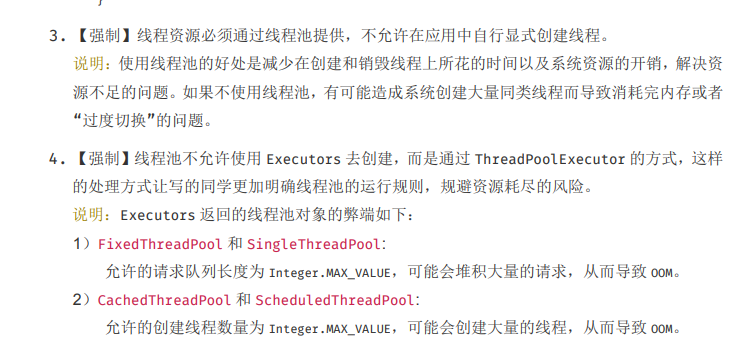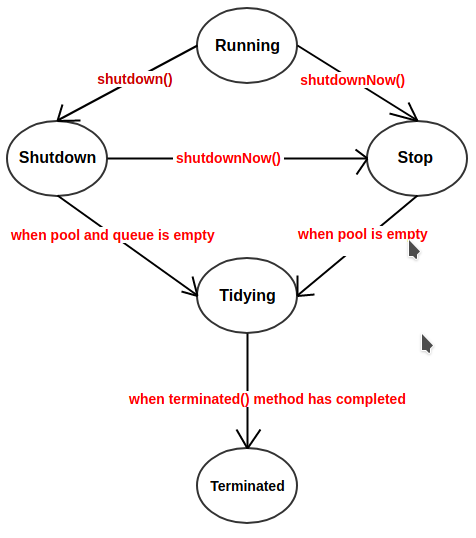重走JAVA之路(五):面试又被问线程池原理?教你如何反击
在 阿里巴巴Java开发手册 中有这么两段话,如下图所示

可以看到提到的两点,第一要求不能显示的创建线程,也就是new Thread的这种形式,需要使用线程池对线程进行管理,第二不允许使用官方提供的四种线程池,而是需要通过自行创建的方式去创建线程池,更加理解线程池的允许规则
本文就基于JDK1.8的代码,对线程池源码进行解析,带大家能够更好的理解线程池的概念以及其运行规则,如有错误,请大家指出
一、ThreadPoolExecutor源码
1.构造函数
先从构造函数看起:
public ThreadPoolExecutor(int corePoolSize,
int maximumPoolSize,
long keepAliveTime,
TimeUnit unit,
BlockingQueue<Runnable> workQueue,
ThreadFactory threadFactory,
RejectedExecutionHandler handler)
复制代码
- corePoolSize :核心线程的数量,默认不会被回收掉,但是如果设置了allowCoreTimeOut为true,那么当核心线程闲置时,也会被回收。
- maximumPoolSize :最大线程数量,线程池能容纳的最大容量,上限被CAPACITY限制(2^29-1)(后续代码会看到)
- keepAliveTime :闲置线程被回收的时间限制,也就是闲置线程的存活时间
- unit :keepAliveTime的单位
- workQueue :用于存放任务的队列
- threadFactory :创建线程的工厂类
- handler 当任务执行失败时,使用handler通知调用者,代表拒绝的策略
有的朋友可能还不是很清晰,举个例子, 一个公司,核心线程就是代表公司的内部核心员工,最大线程数量就是员工的最大数量,可能包含非内部员工,因为有一些试点或者简单的项目,需要一些外协人员来做,也就是非核心线程,那么当这些项目做完了或者失败了,公司为了节约用人成本,就遣散非核心员工,也就是闲置线程的存活时间。假如核心员工每个人都很忙,但是需求又一波接一波,那就任务排期,也就是任务队列,当任务队列都满了时候,还要来需求?对不起,不接受,直接拒绝,这也就是handler对应的拒绝策略了 ,可以例子不是很合适,但是主要帮助大家理解下大概的意思。
2.线程池状态
打开源码类,可以看到如下几个变量
private final AtomicInteger ctl = new AtomicInteger(ctlOf(RUNNING, 0));
private static final int COUNT_BITS = Integer.SIZE - 3;
private static final int CAPACITY = (1 << COUNT_BITS) - 1;
// runState is stored in the high-order bits
private static final int RUNNING = -1 << COUNT_BITS;
private static final int SHUTDOWN = 0 << COUNT_BITS;
private static final int STOP = 1 << COUNT_BITS;
private static final int TIDYING = 2 << COUNT_BITS;
private static final int TERMINATED = 3 << COUNT_BITS;
// Packing and unpacking ctl
private static int runStateOf(int c) { return c & ~CAPACITY; }
private static int workerCountOf(int c) { return c & CAPACITY; }
private static int ctlOf(int rs, int wc) { return rs | wc; }
复制代码
AtomicInteger是一个原子操作类,保证线程安全,采用低29位表示线程的最大数量,高3位表示5种线程池状态,维护两个参数,workCount和runState。workCount表示有效的线程数量,runState表示线程池的运行状态。
- RUNNING :运行状态,可以接受新任务并处理
- SHUTDOWN :关闭状态,不会接受新的任务了,但是会处理队列中还存在的任务
- STOP :停止状态,不会接受新的任务,也不处理队列任务,直接中断
- **TIDYING **:表示所有任务已经终止了
- TERMINATED :表示
terminated()方法已经执行完成
引用一张图片帮助大家理解5个状态

3.执行流程
execute()
public void execute(Runnable command) {
if (command == null)
throw new NullPointerException();
/*
* Proceed in 3 steps:
*
* 1. If fewer than corePoolSize threads are running, try to
* start a new thread with the given command as its first
* task. The call to addWorker atomically checks runState and
* workerCount, and so prevents false alarms that would add
* threads when it shouldn't, by returning false.
*
* 2. If a task can be successfully queued, then we still need
* to double-check whether we should have added a thread
* (because existing ones died since last checking) or that
* the pool shut down since entry into this method. So we
* recheck state and if necessary roll back the enqueuing if
* stopped, or start a new thread if there are none.
*
* 3. If we cannot queue task, then we try to add a new
* thread. If it fails, we know we are shut down or saturated
* and so reject the task.
*/
int c = ctl.get();
//如果当前线程数量小于核心线程数量,执行addWorker创建新线程执行command任务
if (workerCountOf(c) < corePoolSize) {
if (addWorker(command, true))
return;
c = ctl.get();
}
//如果当前是运行状态,将任务放入阻塞队列,double-check线程池状态
if (isRunning(c) && workQueue.offer(command)) {
int recheck = ctl.get();
//如果再次check,发现线程池状态不是运行状态了,移除刚才添加进来的任务,并且拒绝改任务
if (! isRunning(recheck) && remove(command))
reject(command);
//处于运行状态,但是没有线程,创建线程
else if (workerCountOf(recheck) == 0)
addWorker(null, false);
}
//往线程池中创建新的线程失败,则reject任务
else if (!addWorker(command, false))
reject(command);
}
复制代码
这里大概总结下execute方法的执行流程,其实大家看源码方法注释是一样很好的学习方法
- 首先判断当前线程数量是不是比核心线程数量少,如果是,直接创建核心线程执行任务,否则走第二步
- 如果当前线程数量等于核心线程数量了,那么就任务排期,将任务放进任务队列,放入成功后,再次check线程池状态,这里说明一下, 在多线程的环境下,ctl.get()这个方法并不是一个原子操作,如果加入队列后,线程池状态改变了,不是RUNNING状态,那么这个任务将永远不会被执行,所以需要再次check,如果不是RUNNING状态,移除任务并拒绝任务 ,如果是RUNNING状态并且当前没有线程,则直接创建线程
- 走到这一步前提就是第二步中的添加队列失败了,也就是任务队列满了,那么这个时候就考虑到创建非核心线程去执行任务,如果添加非核心线程也失败,那就直接拒绝
这里注意一点,当核心线程满的时候,并不会去直接创建非核心线程去执行任务,而是先放进任务队列,可以理解为需求任务首先是需要让内部核心员工去完成的,任务队列的优先级是高于非核心员工的,addWorker(),这里的传进去的boolean值,就代表着创建核心线程或者非核心线程
reject()
final void reject(Runnable command) {
handler.rejectedExecution(command, this);
}
复制代码
拒绝任务很简单,reject方法会调用handler的rejectedExecution(command,this)方法,handler是RejectedExecutionHandler接口,默认实现是AbortPolicy,下面是AbortPolicy的实现:
public static class AbortPolicy implements RejectedExecutionHandler {
public AbortPolicy() { }
public void rejectedExecution(Runnable r, ThreadPoolExecutor e) {
throw new RejectedExecutionException("Task " + r.toString() +
" rejected from " +
e.toString());
}
}
复制代码
可以看到默认策略是直接抛出异常的,这只是默认使用的策略,可以通过实现接口实现自己的逻辑。
addWorker()
private boolean addWorker(Runnable firstTask, boolean core) {
retry:
for (;;) {
int c = ctl.get();
int rs = runStateOf(c);
// 这里return false的情况有以下几种
//1.当前状态是stop及以上 2.当前是SHUTDOWN状态,但是firstTask不为空
//3.当前是SHUTDOWN状态,但是队列中为空
//从第一节我们知道,SHUTDOWN状态是不执行进来的任务的,但是会继续执行队列中的任务
if (rs >= SHUTDOWN &&
! (rs == SHUTDOWN &&
firstTask == null &&
! workQueue.isEmpty()))
return false;
for (;;) {
int wc = workerCountOf(c);
if (wc >= CAPACITY ||
wc >= (core ? corePoolSize : maximumPoolSize))
return false;
if (compareAndIncrementWorkerCount(c))
break retry;
c = ctl.get(); // Re-read ctl
if (runStateOf(c) != rs)
continue retry;
// else CAS failed due to workerCount change; retry inner loop
}
}
boolean workerStarted = false;
boolean workerAdded = false;
Worker w = null;
try {
w = new Worker(firstTask);
final Thread t = w.thread;
if (t != null) {
final ReentrantLock mainLock = this.mainLock;
mainLock.lock();
try {
int rs = runStateOf(ctl.get());
if (rs < SHUTDOWN ||
(rs == SHUTDOWN && firstTask == null)) {
if (t.isAlive()) // precheck that t is startable
throw new IllegalThreadStateException();
workers.add(w);
int s = workers.size();
if (s > largestPoolSize)
largestPoolSize = s;
workerAdded = true;
}
} finally {
mainLock.unlock();
}
if (workerAdded) {
t.start();
workerStarted = true;
}
}
} finally {
if (! workerStarted)
addWorkerFailed(w);
}
return workerStarted;
}
复制代码
这里就主要流程分析下
- 2层循环,外部循环查询线程池状态,如果当前是stop及之上的状态,直接return,如果是SHUTDOWN状态,并且firstTask不为空或者队列中是空的,直接return
- 内部循环查询线程数量,通过传递进来的boolean值,分别和核心线程以及最大线程数量进行对比,如果成立,worker数量+1,并且跳出循环。
- 跳出循环就是实际执行任务了,Worker就将工作线程和任务封装到了自己内部,我们可以将Worker看成就是一个工作线程,至于Worker是如何执行任务和从阻塞队列中取任务
Worker()
private final class Worker
extends AbstractQueuedSynchronizer
implements Runnable
{
/** Thread this worker is running in. Null if factory fails. */
final Thread thread;
/** Initial task to run. Possibly null. */
Runnable firstTask;
/** Per-thread task counter */
volatile long completedTasks;
Worker(Runnable firstTask) {
setState(-1); // inhibit interrupts until runWorker
this.firstTask = firstTask;
this.thread = getThreadFactory().newThread(this);
}
public void run() {
runWorker(this);
}
......
}
复制代码
可以看到,Worker内部维护,一个线程变量以及任务变量,启动一个 Worker对象中包含的线程 thread, 就相当于要执行 runWorker()方法, 并将该 Worker对象作为该方法的参数.
runWorker()
final void runWorker(Worker w) {
Thread wt = Thread.currentThread();
Runnable task = w.firstTask;
w.firstTask = null;
w.unlock(); // allow interrupts
boolean completedAbruptly = true;
try {
//task不为空,执行当前任务,任务执行完后将task置位空,getTask方法接着不断从队列中取任务
while (task != null || (task = getTask()) != null) {
w.lock();
//再次check线程池状态,如果是stop状态,直接interrupt()中断任务
if ((runStateAtLeast(ctl.get(), STOP) ||
(Thread.interrupted() &&
runStateAtLeast(ctl.get(), STOP))) &&
!wt.isInterrupted())
wt.interrupt();
try {
beforeExecute(wt, task);
Throwable thrown = null;
try {
//执行任务
task.run();
} catch (RuntimeException x) {
thrown = x; throw x;
} catch (Error x) {
thrown = x; throw x;
} catch (Throwable x) {
thrown = x; throw new Error(x);
} finally {
afterExecute(task, thrown);
}
} finally {
task = null;
w.completedTasks++;
w.unlock();
}
}
completedAbruptly = false;
} finally {
processWorkerExit(w, completedAbruptly);
}
}
复制代码
通过while循环不断的调用getTask方法,获取任务task并进行执行,如果任务都执行完,跳出循环,线程结束并减少当前线程数量。
getTask()
private Runnable getTask() {
boolean timedOut = false; // Did the last poll() time out?
for (;;) {
int c = ctl.get();
int rs = runStateOf(c);
// Check if queue empty only if necessary.
if (rs >= SHUTDOWN && (rs >= STOP || workQueue.isEmpty())) {
decrementWorkerCount();
return null;
}
int wc = workerCountOf(c);
// Are workers subject to culling?
boolean timed = allowCoreThreadTimeOut || wc > corePoolSize;
if ((wc > maximumPoolSize || (timed && timedOut))
&& (wc > 1 || workQueue.isEmpty())) {
if (compareAndDecrementWorkerCount(c))
return null;
continue;
}
try {
Runnable r = timed ?
workQueue.poll(keepAliveTime, TimeUnit.NANOSECONDS) :
workQueue.take();
if (r != null)
return r;
timedOut = true;
} catch (InterruptedException retry) {
timedOut = false;
}
}
}
复制代码
这里主要有两个判断需要说明下:
boolean timed = allowCoreThreadTimeOut || wc > corePoolSize
allowCoreThreadTimeOut :这个第一节有说过,如果核心线程设置了该属性,也是需要进行回收的,wc > corePoolSize:当前线程是非核心线程也是需要回收的,满足任何一个条件,timed 置位true
timed ?workQueue.poll(keepAliveTime, TimeUnit.NANOSECONDS) :workQueue.take()
如果上述的timed标志位为true,调用poll方法获取任务,同时设置超时时间,如果没有任务,则超时返回null,跳出runWorker的循环,线程结束被回收,如果为false,调用take方法,此时如果没有任务,不会返回null,而是会进入阻塞状态,等待任务,不会被回收
二、总结
线程池中的细节比较多,大致做一下总结归纳
- 线程池的构造参数决定了线程池的运行策略,需要理解每个参数的含义,因为每个参数的不同很大程度上决定了这个线程池的运行规则,这也是为什么阿里巴巴开发手册中提到通过自行创建的方式去创建线程池,而不是使用官方提供的4种线程池
- 线程池涉及多线程问题,状态改变比较频繁,在进行任务执行时,需要多次check线程池的状态,保证任务被执行的准确性
- 任务队列的优先级高于非核心线程,核心线程满的时候,会先把任务放进任务队列,其次开启非核心线程进行执行
- 核心线程和非核心线程本质上并没有什么区别,在核心线程设置allowCoreThreadTimeOut 属性为true时,最终也会因为超时而被销毁
- 线程池总览就是通过两个变量来整体控制整个流程, 线程池的状态 , 线程池中线程数量 ,涉及的方法不是很多,但是循环比较多,需要理解每个循环的跳出条件以及对应的状态。
大概分析就是这么多,希望有能够帮助到一些朋友更好的理解线程池的工作原理以及在使用中能够更好的使用, 如有疑问或者错误,欢迎一起讨论











![[HBLOG]公众号](https://www.liuhaihua.cn/img/qrcode_gzh.jpg)

